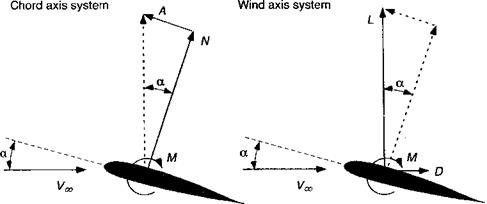Aerodynamics of a Representative Airfoil Section
The resultant forces and moments acting on a typical section of the blade are the net result of the action of the distributed pressure and viscous shear forces, as shown schematically by Fig. 7.14. These forces and moments are obtained by integrating the local values of pressure and shear stress acting normal and parallel to the surface around the airfoil. The forces can be resolved into a wind-axis system (lift and drag) or a chord-axis system (normal force and chord force), as shown in Fig. 7.15. The lift force per unit length, L, acts normal to the velocity, Vqo, and the drag, D, is parallel to Vqo – Alternatively, this lift force can be decomposed into the sum of two other forces as shown in Fig. 7.15: the normal force, N, which acts normal to the airfoil chord, and the leading edge suction force or axial chord force, A, which points upstream and acts parallel to the chord.
7.6.1 Integration of Distributed Forces
Surface shear contributions to the normal force and the pitching moment are small and can usually be neglected. For the axial and drag forces, the shear stress contribution has a measurable effect and should always be included. If we consider the pressure forces
|
Figure 7.15 Decomposition of distributed surface pressure into resultant forces and moments on an airfoil. |
alone, then on the upper surface
dNu = —pudsu cosви, and dAu — —pudsu sm6u, (7.38)
where 6 is the local surface slope. On the lower surface
dNі = pidsi cos9u and dAi — pidsi sinfy. (7.39)
Integrating gives the normal and leading edge suction (axial) forces, respectively
 pi cos в dsi, (7.40)
pi cos в dsi, (7.40)
pi sin 0 dsi, (7.41)
and the moment about the leading edge by
pTE pTE
Mle = I (pux cos 0 + piy sm9)dsu — I (—pix cos 9 + puy sin 9)dsi.
Jle Jle
(7.42)
The lift and the pressure drag are obtained by resolving the chordwise (axial) and normal forces through the AoA a to give
![]() L = N cos a + A sin a,
L = N cos a + A sin a,
D — N sin a — A cos a.
The corresponding force and moment coefficients are defined as
(7.45)
 |
where c is the airfoil reference chord. For a thin-airfoil this gives the normal, suction, and moment coefficients in terms of the pressure coefficient Cp:
The normal force coefficient can generally be used interchangeably with the lift coefficient in the low AoA regime. This can be seen by resolving the normal force and axial chord forces in the lift direction, that is
![]() Ci = Cn cos a + Ca sin a.
Ci = Cn cos a + Ca sin a.
Also, for 2-D potential flow we notice that Ca = Cn tan a (which follows from the fact that Cd — 0), so that
![]() Ci = Cn cosa + Cn tana sina = C„ cosa + 0(a2) « C„.
Ci = Cn cosa + Cn tana sina = C„ cosa + 0(a2) « C„.
For low to moderate angles of attack (i. e., for angles of attack less than 15°) С/ and Cn have almost the same numerical values.












